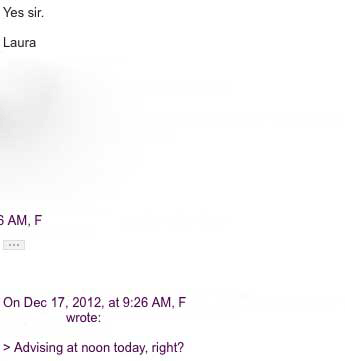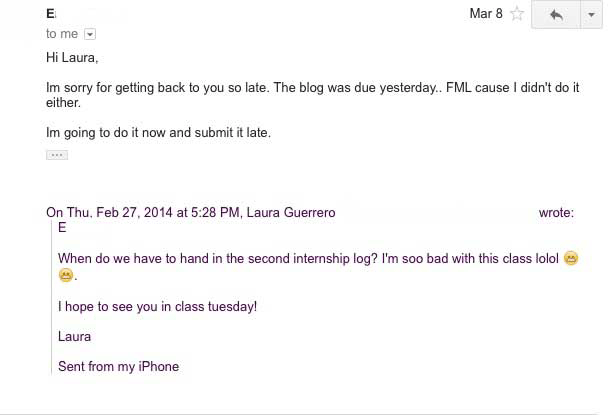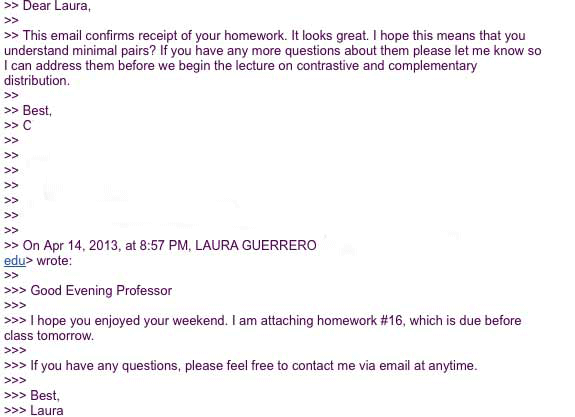Netiquette
When you are in a conversation, you always hope that there never occurs any type of miscommunication. Therefore, you try your best to make your message clear. This can be done by using as few words as possible, giving clear statements/answers, and always telling the truth.
In Linguistics, this is known as the Cooperative Principle, which was coined by Paul Grice. Grice states that we assume “the participants in a conversation will cooperate with each other when making their contributions.”
In the Cooperative Principle, there are 4 Maxims (three if you really think about it) that should always be upheld in any type of conversation:
- Relevance – what you say must always be relevant to the current conversation.
- Quality – do not say something that you know is false; don’t say something that you cannot prove to be true.
- Quantity/Clarity – make sure that what you say is informative to the hearer AND that you will be understood; you shouldn’t give too much information, nor should you give too little.
Because language is forever changing, there are times when certain words/phrases evolve and have different meanings, depending on the context in which they’re being used. As a consequence of this, Maxims are not always observed (if they were, imagine having perfect conversations all the time – wouldn’t that be boring?)
Here are the three ways in which you can use a Maxim:
- Adhere: follow them step by step.
- Violate: it’s not obvious to the hearer that the speaker has lied or been ambiguous during their conversation.
- Flout: it is obvious to the hearer that either someone is being irrelevant, ambiguous, or lying during their conversation (being done on purpose by the speaker).
We know how this related in face-to-face conversations. Now the real questions is, how does this apply to digital conversations? More and more people are ditching the phone in favor of email/text message/social media chats to communicate with friends and loved ones.
So how do we apply Grice’s Maxims to these digital platforms (also known as CMC – Computer Mediated Communication)?
In 1995, The Internet Engineering Task Force (IETF), a large open international community of network designers, operators, vendors and researchers, came up with a set of communication rules, known as Netiquette, that could be respected in any type of online discussion groups. Because discussion groups are not seen as much as before, these rules have become somewhat of a basis for Internet use globally.
The IETF’s goal is to “make the Internet work better by producing high quality, relevant technical documents that influence the way people design, use, and manage the Internet”.
I’ve taken a few samples from my own correspondence with friends/coworkers/family (via emails and text messages) to determine which Maxims are either adhered, flouted, or violated. These Maxims are then related to certain guidelines of Netiquette. So let’s start with the emails first:
NOTE: Please disregard the big blurry thing. I’m still in the process of learning Photoshop.
I like this example because it’s extremely short and sweet. Notice how the person who e-mailed me did not include any salutation at all. He simply asked a question that needed an answer. For my part, I did the same exact thing, plus I knew that what I told him was truthful. I confirmed his belief and was polite about it. So in this case, I would say that we both adhered to Grice’s Maxims of quality, quantity/clarity.
In this case, I didn’t remember when I had to submit a specific assignment, in this case a report. In order to find out, I sent my classmate an email asking her if she knew. Even though we are classmates and get along well, I still followed proper email etiquette by including a salutation, as well as an ending. I was also polite. E in return, gave me the information I needed. So I would say we both adhered to the Maxim of relevance (when our report was due). I could argue that I violated the Maxim of quantity when I went on a short ramble on feeling bad with the class, but it can be argued both ways.
This one I think everyone has sent at least once in their academic career:
As you can tell, I was submitting my homework to this instructor via email (as he requests). You can tell I know that I have to follow proper email etiquette with this instructor – no messing up! I gave both a formal salutation and ending, as well as explained the reason for my email. I conversed with him in a manner that I knew he would find acceptable. The professor on his part confirmed that he received my email and he went a little further in his response by adding a little extra information related to my homework assignment.
This next example is a bit more relaxed, as you can tell:
NOTE: “Pulla” in this context is used as a noun (along the lines of a snide remark).
I actually like this example because we code switched a bit between English, Spanish, and French. In terms of relevance, we followed this Maxim in terms of conversation/email topic. In terms of language used, we mixed it up a bit knowing that we both had an equal understanding of the languages being used, which in turn adhered to the clarity Maxim. Now when it came to the context/information aspect, looking at the first part of the sentence, you can infer that I flouted the Maxim of quantity/clarity by not including an email that M needed (a vital piece of information).
Now, onto the text messages:
For these examples, I collected them through my conversations with friends and family via iMessage:
In this example, because I’m talking to my sister, I don’t send greetings (like “hi”) because, well, 1) it’s a text message, and 2) she’s my sister. Because of these two factors, I don’t have to be too friendly or polite. If I were to do so, then I’d be considered too uptight.
We both adhered to the Maxim of relevance (talking about who’s picking up Derek from school). In terms of clarity, It seems that I violated that Maxim because Ana didn’t understand that I was asking who would pick him up *the next day*. She had to ask me “when?”, and I had to answer back “osea tom[orrow] after school.”
Here are a few other examples of text messages (iMessage):
Translation:
J: What are you doing home?
J: So are you coming or are you coming?
Again in the example, you can notice that code-switching occurs. We both adhere to the Maxim of relevance when using Spanish (we both know we understand it well). In terms of quality, I adhered to it at the end of the conversation bit when I told J that I wasn’t going out because I was “all ready for bed[d].”
However, before that, in terms of quantity, I flouted that Maxim. I wasn’t clear in telling J if I was going out or not until the end of the conversation bit. Instead of giving a straight answer (which I knew what it would be), I kept sending fillers throughout the conversation.
Finally here’s the last text message example:
In this example, we both adhered to all three of the Maxims. A informed me why she was running a bit late, and gave me an approximate time of when she’d be arriving. As a plus, she said “hi” – which is a good thing since she started the text message conversation and it had been a while since we last spoke through text. I on the other hand, was grateful that she let me know of what was going on. I also told her in a polite/friendly manner that she didn’t have to worry about being late, since I could cover for her. We both gave each other enough information to understand what was going on and why.







